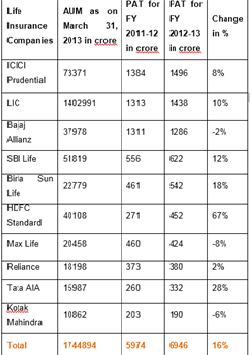ICICI Prudential emerges as most profitable life insurer for the second consecutive year.
The profitability of insurance industry went up by 16% from Rs. 5,974 crore in FY 2011-12 to Rs. 6,946 crore in FY 2012-13, shows an annual report published by IRDA.
The growth in profitability was primarily driven by sales of traditional policies & pension products and higher persistency ratio. Out of 24 life insurance companies, 17 recorded a profit in their business.
Of the top 10 life insurers in terms of AAUM, seven companies saw an increase in their profitability. ICICI Prudential emerged as the most profitable life insurer for the second consecutive year. It has overtaken LIC as the most profitable insurer by registering 8% growth in PAT at Rs. 1,496 crore in FY 2012-13 from Rs. 1,384 in FY 2011-12. LIC’s PAT for fiscal 2012-13 stood at Rs. 1,438 crore, up 10% from Rs. 1,313 crore in FY 2011-12.
HDFC Standard Life recorded a growth of 67% by clocking a net profit of Rs. 452 crore as against a net profit of Rs. 271 crore in FY 2011-12. Similarly, Tata AIA posted a healthy growth of 28% in PAT margin at Rs. 332 crore against Rs. 260 crore in its preceding fiscal.
The profits of Birla Sun Life rose from Rs. 461 crore in FY 2011-12 to Rs. 541 crore in FY 2012-13. SBI Life’s profit grew from Rs. 556 crore in FY 2012-13 to Rs. 622 crore in FY 2013-14. Reliance Life’s PAT too increased from Rs. 373 crore in FY 2011-12 to Rs. 380 crore in FY-2012-13.
Meanwhile, Bajaj Allianz, Max Life and Kotak Mahindra Life recorded a marginal dip in their profits.
Experts attributed this growth increase in sales of traditional policies and pension products. Ritesh Sheth of Tejas Consultancy said that increase in sales of long term traditional policies, especially endowment policies and pension products have contributed significantly to the profits of life insurers.
Though the collection of new business premium declined by 6% in FY 2012-13, the industry witnessed a growth in its profitability. Kapil Narang of Ameriprise India Advisory Services said, “The profitability of an insurance company is not directly related to the first year premium but it is a function of underwriting efficiencies and building good renewals. For example, a company which does a lot of first year business but it’s not good quality would have high claims eat into the profitability. Similarly, if first year premium are high but if persistency is low, it would be difficult to attain profitability. Hence, higher persistency and more efficient underwriting might lead to higher profitability despite low first year premiums. For example, in general insurance, the underwriting losses have reduced from Rs. 8827 crore to Rs. 6984 crore which is a decrease of 21%; this signals higher efficiency and therefore higher profitability.”




